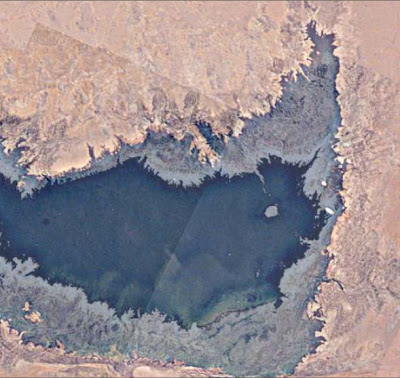Kha was an architect at Deir El-Medina, Egypt, supervisor of some projects completed during the reigns of three kings of the 18th Dynasty (approximately 1440-1350 BC). Buried with his wife Merit, the items of their tomb are exposed at the Egyptian Museum, Torino. The papers at http://arxiv.org/abs/1107.4946 describes some devices of the ancient Egypt masonry (cubits, cords, plumb, levels and squares), that Kha used during his activity. An object among those found in his tomb could be used a protractor.
The figure shows an object from the Kha’s Tomb supposed to be the case of a balance scale, or the scale itself as reported by the corresponding label. In a previous preparation of the items of Kha’s Tomb, it was possible to see the front and back of the object. They are the same, with the same complex decoration.
The tool has a complex decoration, that suggested me the case could be used as a protractor, to determine directions and measure angles. The detail of decoration is shown in the following figure.
We see the 16-fold symmetry of a compass rose with 16 leaves as an inner decoration. Outside this rose there is a polygonal line with 18 corners and then 36 sides. In the inner decoration we can see the fraction 1/16 corresponding to one leaf. The Egyptian knew and used the fractions as the sum of distinct unit fractions. That is, a fraction was written as a sum of fractions, each fraction having a numerator equal to 1 and a denominator equal to a positive integer. Every positive rational number can be represented by an Egyptian fraction. In this ancient system of calculus, the Eye Of Horus defined the Old Kingdom number one, such as, 1 = 1/2 + 1/4 + 1/8 + 1/16 + 1/32 + 1/64, rounded-off at the six-term. A 1/64 is needed to have the exact value 1. The separated parts of the Eye of Horus were used to write describe the fractions. May be, Kha used the balance case for calculations, or simply as a protractor when he was using a plumb, a level or a scale, to find vertical or equilibrium positions, but also to measure the deviation from vertical or horizontal directions.
Is there anything we can tell about number 36, the number of corners of the external decoration of the architect’s case? Let us remember that the Egyptians has the Decans, 36 groups of stars which rise in succession from the horizon due to the earth rotation. The rising of each decan marked the beginning of hours of the night. In the ancient Egypt, the decans were used as a sidereal clock beginning by at least the 9th or 10th Dynasty (ca 2100 BC). Probably, the object found in the Kha’s tomb had simply a geometrical decoration, such as that on another object of the tomb, which seems to be a “rose of direction”.
The use of 1/16 fraction, the coincidence of the number of corners with that of decans, and the fact that the decoration was engraved on the instrument of an architect, suggest me that this object had been used as a protractor instrument with two scales, one based on Egyptian fractions, the other based on decans. Assuming this tool used to evaluate angles, let me show a possible set-up to measure the angle of an inclined plane. Note that the case has a lid. Let us imagine to remove the lid; the case has a perfectly linear side, that can be put on a smooth surface, as shown in the following figure.
When the surface is horizontal, using a plumb to have the vertical direction, one of the directions of the rose of the case coincides with the direction of the plumb (the line between leaves 1-16 or 8-9 seems to be perpendicular to the side of the case). If the surface is inclined, the direction of the rose is inclined forming a certain angle with respect to the vertical. This angle has the same value of the angle of the inclined plane. Geometry originated as a practical science, to measure lengths, surfaces and volumes. In my opinion, Kha could have used his tool, with the contemporary use of a plumb to have a reference direction, to create a set-up able to provide a practical measurement of inclination. The Kha’s protractor could be one of the first devices to measure angles.
References
Turin Egyptian Museum: the tomb of Kha
Deir El Medina: The Painted Tombs, Christine Hobson, Exploring the World of the Pharaohs: A
complete guide to Ancient Egypt, Thames & Hudson, 1993.
Building in Egypt; Pharaonic Stone Masonry, Dieter Arnold, Chapter 6, Tools and their
applications, New York and Oxford, 1991
E. Robens and R.S.H. Mikhail, The ancient Egyptian balance, Thermochimica Acta, Volume
82(1), 1 December 1984, Pages 63-80. 7. Egypt Plumb Bobs, Wolfgang Ruecher, Wolf’s Plumb Bob News, Issue 02, Feb.2010,







